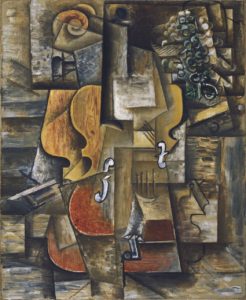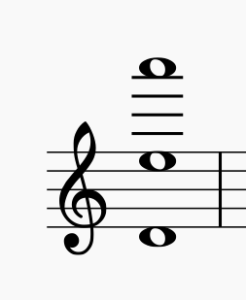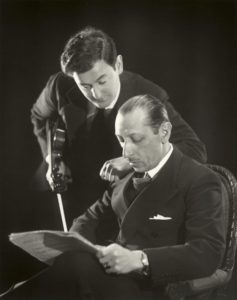Music Director Andrés Orozco-Estrada returns to conduct our first Classical Series concert of the 2019–20 Season: Stravinsky’s Firebird, September 19, 21, and 22. In addition to Stravinsky’s epochal ballet score, the concert features acclaimed virtuoso Leonidas Kavakos in Stravinsky’s Violin Concerto. In this post, discover how the concerto was shaped by the environment of interwar Paris–and one very helpful violinist. Visit houstonsymphony.org for tickets and more information.

Stravinsky’s Violin Concerto dates from 1931, a year far removed from the heady epoch that produced the Scherzo fantastique, The Firebird, and Stravinsky’s other famous works for Diaghilev’s Ballets russes. After the carnage of World War I, artists across Europe began to strive for a new clarity, tranquility, and objectivity in their works, frequently making reference to the styles and abstract forms of the past. Stravinsky, naturally, was in the vanguard of this new movement, which soon became known as “neoclassicism.” With its playful character and light touch, his violin concerto exemplifies this new style.
(Neo)Classical Collaboration
Stravinsky composed the work specifically for the Polish-American violinist Samuel Dushkin, who had studied with Leopold Auer and Fritz Kreisler. Stravinsky was especially attracted by Dushkin’s musical intelligence, because he would need to count on the violinist’s good judgment in creating a work that would showcase an instrument Stravinsky himself did not play. Stravinsky voiced his concerns to the German composer (and violist) Paul Hindemith: “I asked him whether the fact that I did not play the violin would inevitably be to the disadvantage of my composition. He reassured me by saying that, on the contrary, he thought it would help me to avoid a routine technique and would give rise to ideas that would not be suggested by the familiar movement of the fingers.”
Hindemith’s prediction proved prescient, as Dushkin related in a telling incident regarding the chord that opens the piece. “During the winter I saw Stravinsky in Paris quite often. One day when we were lunching in a restaurant, Stravinsky took out a piece of paper and wrote down this chord:

and asked me if it could be played. I had never seen a chord with such an enormous stretch, from the E to the top A, and I said ‘No.’ Stravinsky said sadly ‘Quel domage’ (what a pity). After I got home, I tried it, and, to my astonishment, I found that in that register, the stretch of the eleventh was relatively easy to play, and the sound fascinated me. I telephoned Stravinsky at once to tell him that it could be done. When the concerto was finished, more than six months later, I understood his disappointment when I first said ‘No.’ This chord, in a different dress, begins each of the four movements. Stravinsky himself calls it his ‘passport’ to that concerto.”

In this fashion, the two worked on the concerto, with Stravinsky presenting ideas and Dushkin offering suggestions. “Whenever he accepted one of my suggestions,” Dushkin recalled, “even a simple change such as extending the range of the violin by stretching the phrase to the octave below and the octave above, Stravinsky would insist on altering the very foundations correspondingly. He behaved like an architect who if asked to change a room on the third floor had to go down to the foundations to keep the proportions of the whole structure.”
Such was Stravinsky’s craftsmanship and impeccable ear for the sonorities of different instruments. Indeed, Stravinsky later noted that the concerto’s “texture is almost always more characteristic of chamber music than of orchestral music […] the violin in combination [with other instruments] was my real interest.” The result is a unique work that delights the ear with all manner of piquant and original sonorities.
The Music
The first recording of the concerto was made in 1935 by Dushkin with Stravinsky conducting Les Concerts Lamoureux:
https://www.youtube.com/watch?v=f_7kNFOfqfg
After the opening “passport,” the first movement begins with the presentation of a blithe main idea in the trumpets, which is soon reinterpreted by the soloist. This idea is restated and developed throughout the movement until it returns in its original form near the end. Structurally, the movement is not unlike one by Bach, whose music frequently provided inspiration to Stravinsky during his neoclassical phase. Stravinsky labels this movement a toccata, a type of baroque piece meant to showcase dexterity, and though the movement is full of Stravinsky’s signature metrical changes and rhythmic games, the music adheres to a steady, walking pace tempo throughout, much in the baroque manner. The music however, is distinctly modern, full of passing, fragmentary musical allusions: we hear a violinist practicing Brahms’ Double Concerto, scraps of a popular waltz tune, a baroque musette, and a barrel organ churning out faux-Tchaikovsky. It is easy to imagine Stravinsky dreaming up this music while strolling through Paris on a bracing spring day.
The second movement, Aria I, has a more melancholy cast, which is nevertheless undercut by cheeky irony throughout. After the opening “passport” chords, the soloist launches into a weepy melody which soon becomes overrun with ornamentation—a nod to the often florid singing of the baroque era. A lighter, syncopated idea later appears in the strings beneath the soloist’s high, whistling harmonics, notes produced by barely touching the violin’s strings. The music then becomes more fragmented and developmental, building to the mock crisis of a diminished chord in the winds and brass (listeners may recognize this as the harmony typical associated with a woman tied to the train tracks in silent movies). The main theme is then reprised, leading to an impish final note.
By contrast, the next movement, Aria II, seems more sincere, attaining real pathos and beauty. The “passport” chord takes on a more strident tone as it begins the movement, leading to a poignant melody for the soloist. The tempo quickens for a contrasting passage featuring a breathless, pulsing accompaniment, before a reprise of the main theme.
Any lingering shadows are swept away as the “passport” chord ushers in the playful finale, titled Capriccio (“caprice”). After some introductory flourishes, the soloist introduces a rustic fiddle tune above a humorously earthy “boom-chick” accompaniment of bassoons (the practice of maintaining a “high tone” for earlier movements and then letting one’s hair down for a more folksy finale was common in eighteenth century music). As the movement unfolds, savvy listeners may recognize hints of the first movement of Bach’s “Double” Violin Concerto in D minor, BWV 1043, one of Stravinsky’s favorite pieces. Stravinsky himself acknowledged Bach’s concerto as the inspiration for a later passage when the soloist is joined by a violin from the orchestra for a duet. The tempo picks up for a presto finale, bringing the concerto to a spirited, virtuoso conclusion.
Don’t miss Stravinsky’s Violin Concerto at Stravinsky’s Firebird, September 19, 21, and 22. Visit houstonsymphony.org for tickets and more information.



